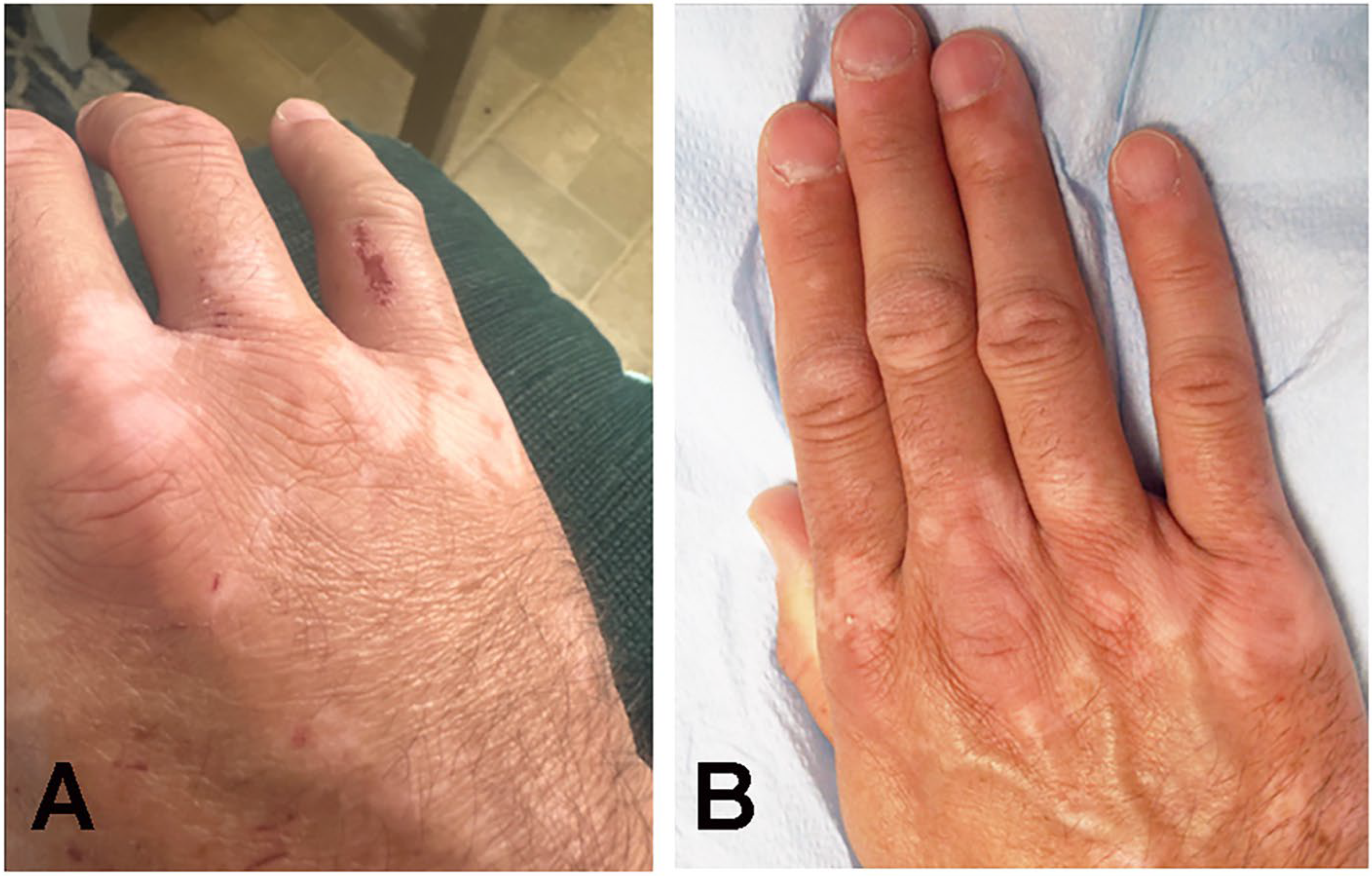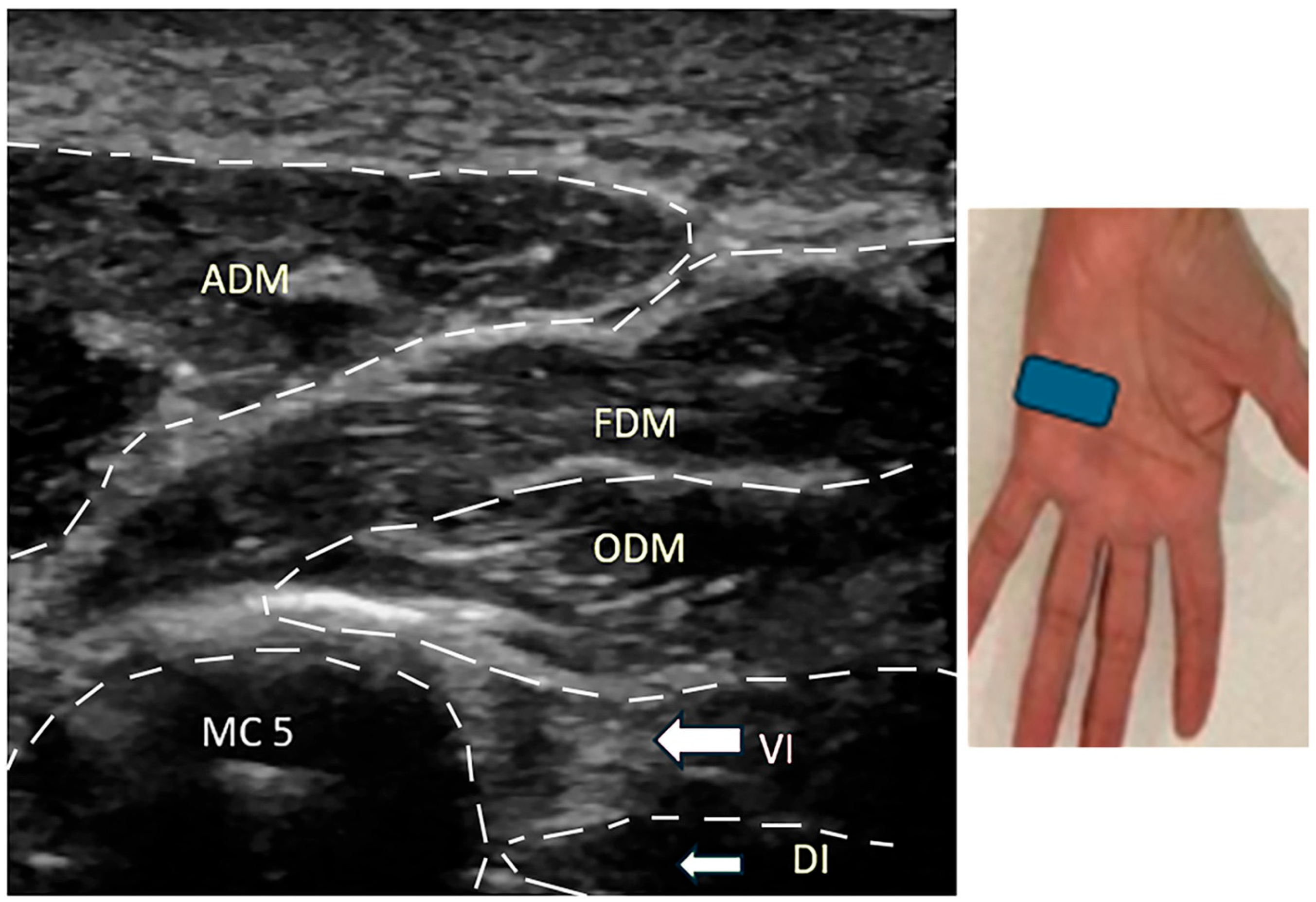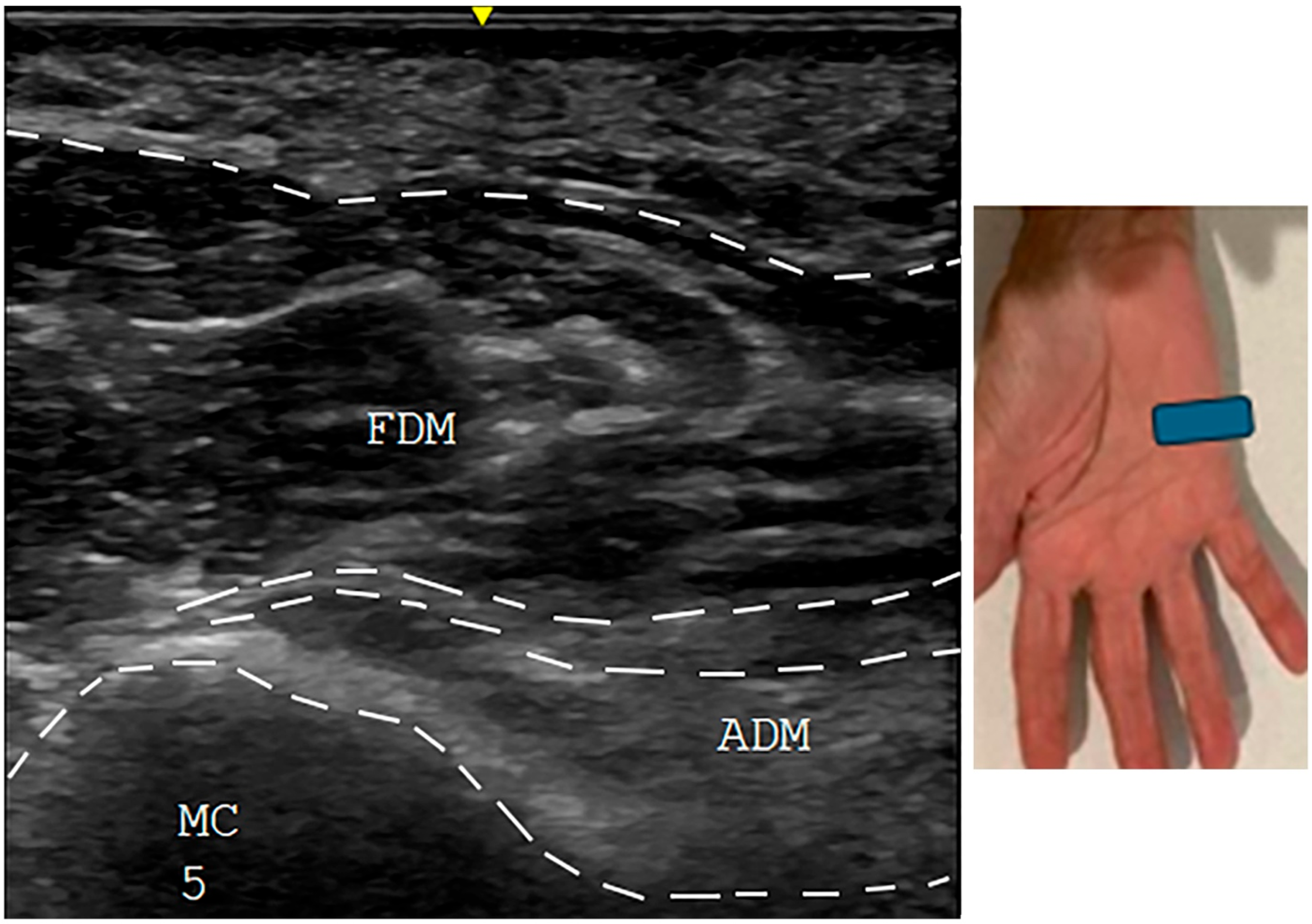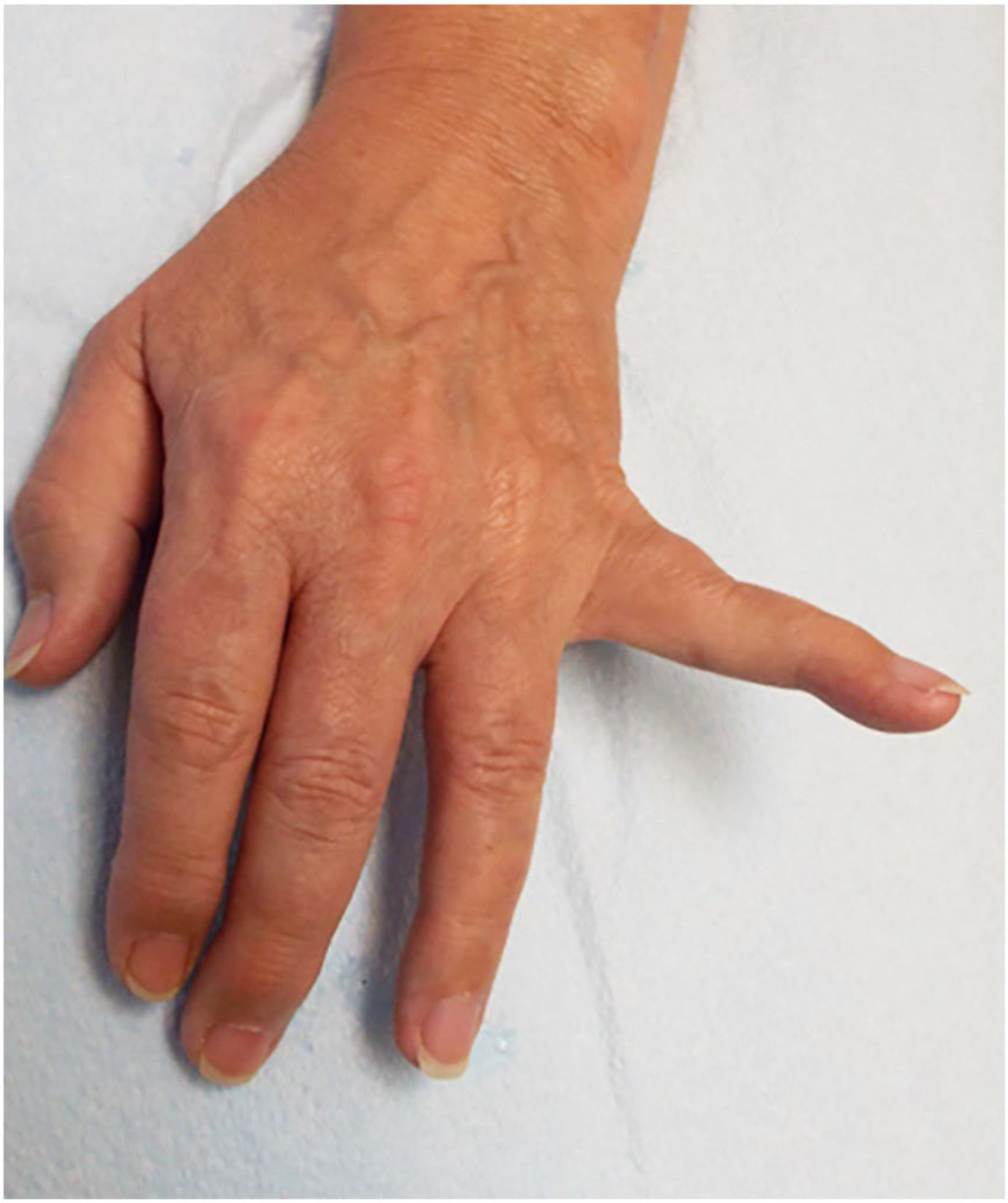A Retrospective Study of 10 Patients Exhibiting the “Pseudo Wartenberg Sign”
Abstract
1. Introduction
2. Materials and Methods
2.1. Inclusion and Exclusion Criteria
2.2. Institutional Review Board Approval of Research
3. Results
3.1. Demographics
3.2. Clinical Features
3.3. Electrodiagnostic Studies
3.4. Ultrasound Studies
3.5. Etiologies and Mechanisms
4. Discussion
Strengths and Limitations
5. Conclusions
Author Contributions
Funding
Institutional Review Board Statement
Informed Consent Statement
Data Availability Statement
Conflicts of Interest
References
- Wartenberg, R. Nerves of the arm: Some of their affections; their diagnosis. Cal. West. Med. 1943, 59, 22–24. [Google Scholar] [PubMed]
- Wartenberg, R. A sign of ulnar palsy. JAMA 1939, 112, 1688. [Google Scholar] [CrossRef]
- Lourie, G.M.; Lundy, D.W.; Rudolph, H.P.; Bayne, L.G. Abducted, hyperextended small finger deformity of nonneurologic etiology. J. Hand. Surg. Am. 1999, 24, 315–319. [Google Scholar] [CrossRef] [PubMed]
- Gonzalez, M.H.; Gray, T.; Ortinau, E.; Weinzweig, N. The extensor tendons to the little finger: An anatomic study. J. Hand. Surg. Am. 1995, 20, 844–847. [Google Scholar] [CrossRef]
- Kilgus, M.; Burg, D.; Loss, M.; Weishaupt, D.; Meyer, V.E. Wartenberg’s sign of ulnar nerve lesion. A contribution to pathophysiology and to the differential diagnosis. Handchir. Mikrochir. Plast. Chir. 2003, 35, 251–258. [Google Scholar]
- Hoff, H.; Schilder, P. Phanomen des kleinen fingers. Dtsch. Med. Wehnschr. 1928, 54, 1200. [Google Scholar] [CrossRef]
- Kuschner, S.H.; Berihun, H. Robert Wartenberg syndrome and sign: A review article. Open. J. Orthop. 2021, 15, 13–16. [Google Scholar] [CrossRef]
- Morisaki, S.; Tsuchida, S.; Oda, R.; Toyama, S.; Takahashi, K. Fourth dorsal interosseous muscle transfer to treat an abducted little finger. J. Hand. Surg. Am. 2022, 47, 95.e1–95.e4. [Google Scholar] [CrossRef]
- Yacoubi, H.; Najib, A.; Daoudi, A. Permanent abduction of the little finger without ulnar nerve palsy: A case report. Chir. Main. 2012, 31, 266–268. [Google Scholar] [CrossRef] [PubMed]
- Vincent, M.B. A note on the digiti quinti sign in hemiplegic migraine. Cephalalgia 2009, 29, 580–582. [Google Scholar] [CrossRef] [PubMed]
- Micev, A.J.; Ivy, A.D.; Aggarwal, S.K.; Hsu, W.K.; Kalainov, D.M. Cervical radiculopathy and myelopathy: Presentations in the hand. J. Hand. Surg. Am. 2013, 38, 2478–2481. [Google Scholar] [CrossRef] [PubMed]
- Freeland, A.E.; Barrett, G.R.; Wheeless, G.S. Correction of abduction: Deformity of the small finger caused by avulsion of the insertion of the third volar interosseous muscle. Am. J. Sports. Med. 1985, 13, 273–276. [Google Scholar] [CrossRef]
- Alter, M. The digiti quinti sign of mild hemiparesis. Neurology 1973, 23, 503–505. [Google Scholar] [CrossRef]
- Goto, K.; Murakami, T.; Nakamura, T.; Saku, I. Traumatic injury of the third palmar interosseous muscle in a patient with dementia. Trauma. Case. Rep. 2022, 40, 100654. [Google Scholar] [CrossRef] [PubMed]
- Iyer, V.G. Understanding nerve conduction and electromyographic studies. Hand. Clin. 1993, 9, 273–287. [Google Scholar] [CrossRef] [PubMed]
- Bellan, N.; Belkhiria, F.; Touam, C.; Asfazadourian, H.; Oberlin, C. Extensor digiti minimi tendon “rerouting” transfer in permanent abduction of the little finger. Chir. Main. 1998, 17, 325–333. [Google Scholar] [CrossRef] [PubMed]
- Voche, P.; Merle, M. Wartenberg’s sign: A new method of surgical correction. J. Hand. Surg. Br. 1995, 20, 49–52. [Google Scholar] [CrossRef] [PubMed]
- Torres-Russotto, D.; Perlmutter, J.S. Focal dystonias of the hand and upper extremity. J. Hand. Surg. Am. 2008, 33, 1657–1658. [Google Scholar] [CrossRef] [PubMed]
- Lin, P.T.; Hallett, M. The pathophysiology of focal hand dystonia. J. Hand. Ther. 2009, 22, 109–113. [Google Scholar] [CrossRef] [PubMed]
- Iyer, V.; Thirkannad, S. Focal hand dystonia in a patient with ulnar nerve neuropathy at the elbow. Hand 2010, 5, 453–457. [Google Scholar] [CrossRef] [PubMed]





| Case Number | Age (Years)/ Gender | Cause | Mechanism | Duration of Symptoms | Side | Physical Examination |
|---|---|---|---|---|---|---|
| 1 | 48/M | MVA: little finger caught in steering wheel | Injury: avulsion of third volar interosseous | 8 months | Right | Little finger stays abducted; weakness of adduction of little finger towards ring finger |
| 2 | 18/M | No injury | ADM/EDM dystonia | 2 weeks | Right | Little finger stays abducted, more when fingers are fully extended |
| 3 | 57/M | Laceration: between digits 4 and 5 | Injury: avulsion of volar third interosseous muscle | 5 months | Left | Little finger stays abducted; weakness of adduction of little finger towards ring finger |
| 4 | 54/F | Pulling clothes out of 60-pound washing machine | Injury: ADM/EDC dystonia secondary to CRPS | 2 years | Left | Little finger stays abducted; tenderness left hypothenar area/ little finger/ulnar palm; erythema/allodynia/ hyperalgesia over hypothenar area |
| 5 | 54/F | Injury mostly of digit 3 | ADM/EDM dystonia | 10 months | Right | Little finger stays abducted; weakness of adduction of little finger towards ring finger; able to voluntarily adduct little finger when the digits are flexed at the MP joints |
| 6 | 71/F | No injury | ADM/EDM dystonia | 6 months | Left | Little finger stays abducted; weakness of adduction of little finger towards ring finger |
| 7 | 61/M | Injury of left wrist | Injury: contracture of ADM | childhood | Left | Little finger stays abductued; weakness of adduction and abduction of little and ring fingers |
| 8 | 57/F | No injury | ADM/EDM dystonia | 6 months | Right | Little finger stays abducted; weakness of adduction of little finger towards ring finger when fingers are extended |
| 9 | 52/F | No injury | ADM/EDM dystonia | 1 year | Right | Little finger stays abducted; weakness of adduction of little finger towards ring finger when fingers are extended |
| 10 | 15/F | No injury | EDM dystonia | 4 months | Right | Little finger stays abducted; hyperextension at the MP joint when adduction is attempted |
| Publication | Number of Patients | Cause | Mechanism | Treatment |
|---|---|---|---|---|
| Freeland et al. [12] | 1 | Injury: playing ball | Deformity of little finger caused by avulsion of the insertion of the third volar interosseous muscle | Transferring ulnar tendon of EDM to phalangeal attachment of the radial lateral band |
| Lourie et al. [3] | 6 | Unspecified trauma | Axially directed force to little finger with hyperabduction | Five patients had 4 weeks of immobilization holding metacarpophalangeal joints in 40° flexion and the interphalangeal joins in extension; three of these patients underwent plication of radial collateral ligament and imbrication of radial sagittal band and junctura tendinum |
| Yacoubi et al. [9] | 1 | Unspecified trauma | Avulsion of the insertion of the third volar interosseous muscle | Transfer of the EDM onto the radial side of the EDC |
| Goto et al. [14] | 1 | Injury: laceration between ring and little fingers | Third volar interosseous muscle injury | Fourth flexor digitorum superficialis tendon transfer |
| Morisaki et al. [8] | 1 | Injury: lifting heavy object with hyperabducted little finger | Rupture of the third volar interosseous muscle | Transfer of the fourth dorsal interosseous muscle to the lateral band of the little finger |
Disclaimer/Publisher’s Note: The statements, opinions and data contained in all publications are solely those of the individual author(s) and contributor(s) and not of MDPI and/or the editor(s). MDPI and/or the editor(s) disclaim responsibility for any injury to people or property resulting from any ideas, methods, instructions or products referred to in the content. |
© 2025 by the authors. Licensee MDPI, Basel, Switzerland. This article is an open access article distributed under the terms and conditions of the Creative Commons Attribution (CC BY) license (https://creativecommons.org/licenses/by/4.0/).
Share and Cite
Shields, L.B.E.; Iyer, V.G.; Zhang, Y.P.; Shields, C.B. A Retrospective Study of 10 Patients Exhibiting the “Pseudo Wartenberg Sign”. Neurol. Int. 2025, 17, 97. https://doi.org/10.3390/neurolint17070097
Shields LBE, Iyer VG, Zhang YP, Shields CB. A Retrospective Study of 10 Patients Exhibiting the “Pseudo Wartenberg Sign”. Neurology International. 2025; 17(7):97. https://doi.org/10.3390/neurolint17070097
Chicago/Turabian StyleShields, Lisa B. E., Vasudeva G. Iyer, Yi Ping Zhang, and Christopher B. Shields. 2025. "A Retrospective Study of 10 Patients Exhibiting the “Pseudo Wartenberg Sign”" Neurology International 17, no. 7: 97. https://doi.org/10.3390/neurolint17070097
APA StyleShields, L. B. E., Iyer, V. G., Zhang, Y. P., & Shields, C. B. (2025). A Retrospective Study of 10 Patients Exhibiting the “Pseudo Wartenberg Sign”. Neurology International, 17(7), 97. https://doi.org/10.3390/neurolint17070097






